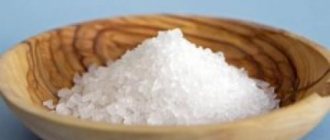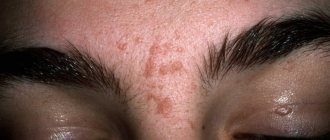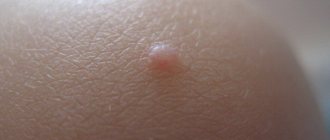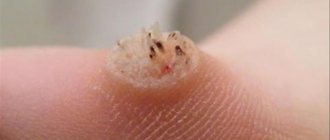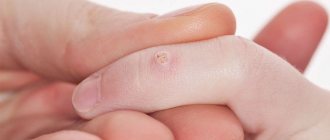Bleeding is always a concern . Even those people who are not inclined to faint at the sight of blood may become frightened when they discover the appearance of bloody discharge from nevi. Everyone knows about the ability of birthmarks to degenerate into malignant formations, so concern may not be unfounded .
Photo 1. Bleeding from a mole is a reasonable cause for concern. Source: Flickr (Ryan)
Why does a mole bleed?
Healthy birthmarks have a stable size and color. But if blood engorgement suddenly occurs, or bleeding appears, this is a sign of concern. There are two reasons for the formation of blood fluid in a nevus - mechanical injury and the course of pathology.
Injury to nevus
This phenomenon occurs if a person accidentally touches a birthmark while washing the body, dressing, or playing. If the stain is torn off, there will definitely be blood. Statistics show that birthmarks are most often picked off by children and women. Men have to deal with cuts while shaving, bathing, and changing clothes.
Here are the most common situations of injury to nevi in women:
- touching a handbag,
- wearing jewelry incorrectly,
- stripping during hair removal,
- grazing with a long nail,
- combing.
In children the reasons are identical. In addition, they may have unsuccessful play with peers or be scratched by cats and dogs. According to statistics, children often damage such formations in their sleep.
Pathological causes
If blood fluid oozes, and there was no previous injury, there is a high probability of an inflammatory process in the tissues. He caused the bleeding. If the mole was torn off, in the patient's opinion, for no particular reason, the tissue may have become necrotic.
Types of mole injuries
The lion's share of patients mistakenly assume that such injuries can only be dangerous if the tumor is cut off. But medical removal is considered the safest, since during the therapy all parts of the nevus are cut out.
Poor consequences and prognosis can overtake the patient in the following practical situations:
- regular rubbing of the birthmark with jewelry, underwear, clothes,
- scratching when unsuccessful scratching occurs,
- excessive pressure factor, if a person wears a belt, abuses tight clothes, uncomfortable shoes,
- cutting when shaving.
A person is not always able to notice on his own that he has caused damage to a birthmark. Therefore, it is necessary to monitor the process of pigmentation of nevi and make timely visits to the doctor.
Why is bleeding from a mole dangerous?
Moles are traditionally benign formations. Therefore, they themselves do not pose any danger, at least as long as their shape, color and size remain the same. If some changes begin to occur, this may be a signal that the birthmark has degenerated into a malignant tumor. And this already requires medical intervention. If there are moles on the human body that suddenly begin to change, you need to visit a doctor, get tested and undergo a course of therapy.
Normal recovery after surgery
If the intervention is performed by an experienced specialist, then the wound healing process proceeds normally. All you need is time and proper care.
- In the first week, a crust forms. The most important thing is not to touch her. In the first few hours, the wound may bleed a little, especially if it was removed using a scalpel. Avoid getting it wet or accidentally damaging it. In some cases, it is recommended to rinse with a light solution of potassium permanganate and apply an antibacterial ointment prescribed by a doctor.
- Second week - the crust on a small growth often falls off. In larger formations, it may still persist, and the skin underneath may itch. The exposed layer of thin epidermis requires protection from sunlight, and visiting a solarium is prohibited at this time.
- By the third week, the operation site should no longer hurt or bleed, even when affecting a large area. The redness goes away. If the laser method was used, then everything should be fine by this time. The application site is no different from normal skin.
- The fourth week is considered the last. At this moment, the patient forgets that he was once bothered by a nevus or birthmark. And the wound heals completely.
How to stop bleeding at home
If the mole is filled, before the ambulance arrives (in serious situations) or goes to the clinic, it is necessary to carry out home tactics to prevent the infection from getting inside.
Here's what you need to do to stop the bleeding process.
- Wash your hands and disinfect them with alcohol.
- Wear sterile medical gloves.
- Treat the resulting wound with hydrogen peroxide, applying it to a clean cotton pad.
- To stop the bleeding, a bandage is applied to the affected area for a period of 15-20 minutes.
- Then the wound is re-lubricated with Chlorhexidine solution.
- In order for the damaged area to heal as quickly as possible, it is necessary to lubricate it with zinc-based ointment or calendula-based infusion.
As the area heals, a crust will form. It is forbidden to rip it off yourself.
It is important to know! To avoid penetration of pathogenic microorganisms into the growth or the place left behind it, you can treat it with iodine, brilliant green, or manganese solution. If a piece accidentally comes off from a growth, you should not try to tear off the remaining part yourself - consult a doctor. He will order a histological analysis and tell you what to do next.
The duration of the recovery process is about 20 days.
Possible complications after removal
If you neglect the process of removing a mole, then melanoma, a scar, and a scar may appear at the site of the formation. Excessive bleeding is also possible. To avoid complications, it is important to follow the specialist’s recommendations and periodically treat the wound with an antibacterial agent prescribed by the specialist. It is important not to pick off the scabs and not visit the solarium until complete recovery.
Traditional methods of treatment can greatly harm and aggravate the problem. In order not to provoke the development of complications, the neoplasm should be diagnosed in a timely manner. People with a family history of cancer should regularly visit an oncologist, since many diseases (or rather, a tendency to them) are transmitted genetically.
What are they doing at the hospital?
Blood at the site of a mole traditionally requires seeing a doctor, especially if the damage is significant. The doctor prescribes tests (tissue biopsy, histology) and, if there is significant tearing, takes measures for removal.
The modern medical field is ready to offer the following methods for eliminating birthmarks:
- electrocoagulation (elimination of formation is carried out using current, there is a possibility of scars, so the technique is relevant in the treatment of moles located in inconspicuous areas),
- radiotherapy (the procedure does not involve infection, therefore in practice it is used especially often; scars as a consequence are likely in isolated situations),
- laser therapy (is the most common manipulation for removing growths, since it does not cause pain and does not leave scars),
- elimination with liquid nitrogen (the birthmark is frozen, as a result, old cells die and fall off on their own),
- surgical intervention (removal is performed using a medical scalpel, indicated for large tumors located in the deep layers of the skin).
Popular methods and care
Currently, there are several methods for eliminating moles; the choice is usually made by a specialist. The doctor takes into account many factors - localization, likelihood of malignancy, area of skin damage.
Laser
The most precise impact is achieved when using a laser. This method is currently the most optimal. Experts highlight a number of positive aspects of this manipulation:
- local anesthesia makes the procedure virtually painless, even a child can easily endure it;
- duration is only 5-10 minutes;
- narrowly targeted beam exposure and the ability to control the depth of action prevent damage to surrounding tissues;
- soft and layer-by-layer removal of the nevus occurs;
- no bleeding;
- There are almost never any traces left after manipulation;
- minimum rehabilitation period (no more than 1-2 weeks).
Despite the positive aspects of laser destruction, it also has some disadvantages:
- inability to conduct histology of a mole after removal;
- not all hospitals have the most modern equipment;
- For normal healing, it is necessary to exclude ultraviolet irradiation and thermal procedures for some time.
The application area is treated with any antiseptics that do not contain alcohol, otherwise a burn to the young skin may occur, after which a scar will form.
If everything is done correctly, the resulting crust falls off, and a red spot may remain in its place for some time. But then it disappears. Therefore, laser removal is used mainly to eliminate formations on open parts of the body. If a scar forms at the site of removal, you can get rid of it by using a special patch with a silicone base. Contractubex or Dermatix ointment is also suitable. You can apply Panthenol or similar products to speed up regeneration.
Cryodestruction
This method uses liquid nitrogen, the temperature of which is minus 180 degrees Celsius. In this case, the tissue completely dies, a crust forms on top, under which the dermis is gradually restored. The procedure is not practiced in the facial area. Complete healing may take about a month.
Cryodestruction allows you to remove even a fairly large formation. During the session, the application site is completely disinfected due to the low temperature. The removal process itself proceeds quickly, leaving no traces in the form of a scar or scar. In addition, the patient does not experience pain.
The negative aspects of this method include:
- inability to conduct histological examination;
- getting burned;
- the need for a repeat procedure.
The doctor's lack of experience in such manipulations often leads to damage to surrounding healthy tissue.
On the first day, it is recommended to use hydrogen peroxide or a solution of potassium permanganate to treat a cold burn. For sensitive skin, antihistamine or antipruritic ointment (Fenistil, Nezulin) will help relieve itching. You should not scratch, as this easily damages the crust and the unformed tissue underneath it. For some time after the manipulation, a red spot may persist, gradually acquiring the color of normal skin.
Radio wave therapy
The radio wave method allows you to treat any problem area and at the same time preserve the tissue for research. The healthy part of the dermis is not disturbed, and no scars are left.
The method is especially suitable for cutting out tubercles that protrude greatly above the surface. The disadvantage of this technique is the impossibility of removing large formations. The risk of repeating the process, when the mole may appear again, is practically eliminated.
After radio wave removal, you should not wet the resulting crust and expose your body to the sun's rays . Only disinfection should be carried out: rinse with antiseptics in the first hours, lubricate with antibacterial ointments. The doctor may prescribe Chlorhexidine, potassium permanganate, Levomycetin, Pantoderm. You cannot use cosmetics.
Electrocoagulation
This procedure eliminates various formations using high current. In this case, tissue coagulation occurs, a crust appears, which then falls off. Manipulation is performed on any area of the skin. One session is enough. After this, no wound surface is formed, no bleeding is observed, since the vessels coagulate along with the mole.
After the crust is separated, a scar in this place can remain only in exceptional cases. Most often, a small spot appears, slightly lighter than normal skin, which will go away over time. If electrocoagulation or radioknife is used, the removed tissue is preserved. It can be examined for the presence of atypical cells. The procedure is prescribed if it is necessary to eliminate warts, papillomas, hemangiomas, keratomas (in old age), and complicated acne. It is successfully used in the treatment of atheroma, spider veins, and formations after the introduction of molluscum contagiosum. Electrocoagulation is effective for removing a mixed type of nevus when cancerous degeneration is suspected. A positive aspect of the method is the ability to control the depth of exposure.
It is forbidden to wet the crust at the operation site or expose it to insolation . Then she needs to be protected from traumatization. Additional care in the form of applying local antibiotics and antiseptics is required only in case of infection.
Using a scalpel
The oldest method is to cut out the spot or nevus using conventional surgery. It is time-tested, its price is affordable for everyone. The intervention is carried out under local anesthesia and lasts approximately an hour. After excision, a wound is formed that requires treatment. When a wart or mole is located deeply, a hole is formed. If a large nevus is removed, then for normal healing the doctor applies a suture, which is removed after a week.
- high probability of scarring;
- bleeding during and after surgery;
- the patient needs rehabilitation.
- no need to look for a clinic with expensive equipment;
- the operation can be performed by a surgeon without additional skills and long-term experience;
- It is possible to excise formations of any depth and area of the lesion.
Which doctor should I contact?
If blood appears in the area of formation, this can cause adverse consequences, including death (in the absence of timely treatment measures).
Here are several types of growths that must be demonstrated to a dermatologist:
- giant pigmented mole,
- birthmark like papilloma,
- borderline neoplasm with pigment accumulation,
- dysplastic nevus,
- blue nevus,
- nevus of Ota.
When a mole bleeds, the phenomenon itself does not pose any danger, even if it continues for a long period. This indicates damage to a large number of small blood vessels. However, if there is a noticeable change in shape, size, or color, a consultation with an oncologist is required. After all, a degenerated nevus is the source of the formation of a cancer-type tumor.
Recommendations from experts
If a person has pigmented spots on the body, it is important to follow the recommendations of skin care specialists. Namely:
- spend less time in the sun;
- do not visit the solarium;
- control the level of hormones in the body;
- You should wear comfortable shoes (appropriate to your size);
- be careful when performing everyday tasks.
A bleeding mole should be sealed to prevent infection from entering the body. Doctors prohibit removing nevi on your own, since you can introduce an infection into the body and seriously harm your health.
Prevention of bleeding from moles
The fact of damage to a mole is not noticeable from the first stage of damage. It makes itself felt in the process of starting the inflammatory process. In order to minimize the likelihood of an ordinary mark degenerating into a malignant formation, it is worth paying attention to a number of methods.
- Reduce contact with moles to prevent mechanical changes.
- Using the patch as an effective preventive measure against stripping. This will wean the patient from picking at the growth.
- If the nevus is located in the leg area, shoes are selected so that its impact on the growth area is minimized.
- Constant monitoring of hormonal levels is the key to successful therapy for nevus.
- An important role is played by preventing the abuse of ultraviolet rays in solariums and outdoors.
Thus, if bleeding comes from a mole, you can stop it at home, but to avoid negative consequences, you should consult a doctor.
Possible consequences
Most often, nevus removal proceeds safely, but in some cases negative consequences of manipulation may occur:
- the appearance of inflammation and infection;
- swelling or new formation (high probability of developing a tumor);
- swelling and hyperemia;
- bleeding;
- soreness and discomfort;
- keloid scar;
- compaction;
- area of hypo- or hyperpigmentation;
- increase in local or general temperature.
In some cases, a new one may appear at the site of the removed spot. This phenomenon occurs when the manipulation is carried out incorrectly, when some of the mutated cells remain in the tissue.
Relapse requires an even more thorough examination and is eliminated exclusively by repeated removal with mandatory histological examination. This is especially important if there is a sore that itches or bleeds.

